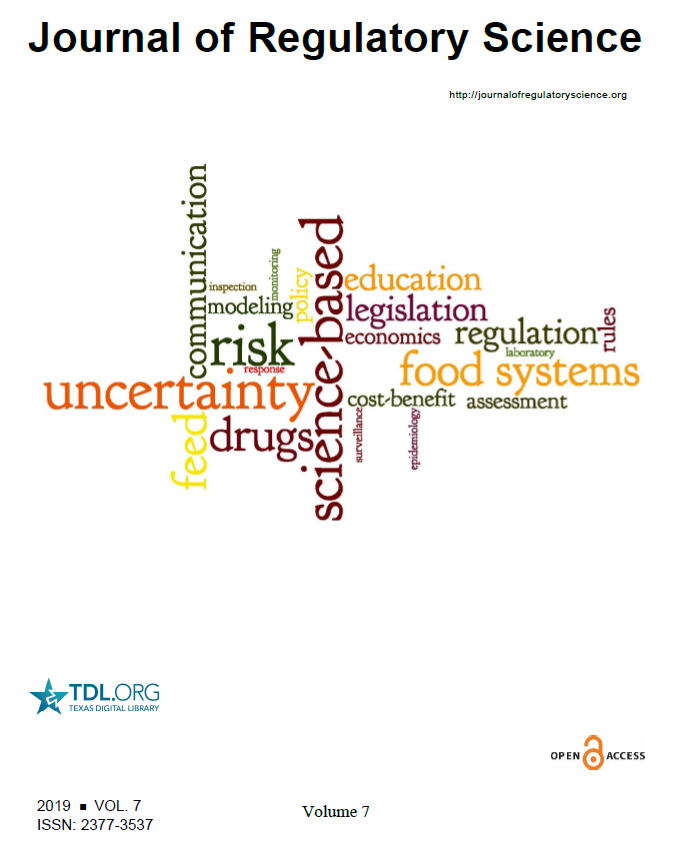Multi-laboratory evaluation of staphylococcal enterotoxin detection by the RIDASCREEN® SE A, B, C, D, E ELISA kit
DOI:
https://doi.org/10.21423/JRS-V07P001Keywords:
Staphylococcal enterotoxins, RIDASCREEN, SET, SEAbstract
The RIDASCREEN® SE A, B, C, D, E kit was evaluated for use as a secondary test for the detection of staphylococcal enterotoxins in meat matrices Seven state agriculture and public health laboratories participated in the study. The study demonstrated that the kit is able to detect each of the five serotypes in hot dogs, breaded chicken nuggets, bologna, and ready-to-eat barbeque meat. Staphylococcal enterotoxins were detected at a minimum of 1.0 ng/g in all matrices and at levels as low as 0.375 ng/g in some matrices. While cross-reaction between some serotypes is seen, false negative and false positive results were minimally observed. When used along with the BioMerieux VIDAS® SET2 automated immunoassay test, this kit provides a secondary assay to use as confirmation for the presence of staphylococcal enterotoxins in a meat sample.
https://doi.org/10.21423/jrs-v07p001
References
AOAC International. Official Methods of Analysis. Retrieved from http://www.eoma.aoac.org/methods/info.asp?ID=49057
Argudin, M. A., Mendoza, M. C., & Rodicio, M. R. (2010). Food poisoning and Staphyloococcus aureus enterotoxins. Toxins, 2(7), 1751-1773.
Bennett, R. W. (2005). Staphylococcal enterotoxin and its rapid identification in foods by enzyme-linked immunosorbent assay-based methodology. Journal of Food Protection, 68(6), 1264-1270.
Dupuis, S., Hennekinne, J-A., Garin, J., & Brun, V. (2008). Protein Standard Absolute Quantification (PSAQ) for improved investigation of staphylococcal food poisoning outbreaks. Proteomics, 8(22), 4633-4636.
Genigeorgis, C. A. (1989). Present state of knowledge on staphylococcal intoxication. International Journal of Food Microbiology, 9(4), 327-360.
Hait, J. M., Tallent, S. M., & Bennett R. W. (2014). Screening, detection, and serotyping methods for toxin genes and enterotoxins in Staphylococcus strains. Journal of AOAC International, 97, 1078-1083.
Hennekinne, J-A., De Buyser, M-L., & Dragacci, S. (2012). Staphylococcus aureus and its food poinsoning toxins: characterization and outbreak investigation. FEMS Microbiology Review, 36, 815-836.
Mamone, G., Picariello, G., Caira, S., Addeo, F., & Ferranti, P. (2009). Analysis of food proteins and peptides by mass spectrometry-based techniques. Journal of Chromatography A, 1216(43), 7130-7142.
Ostyn, A., Guillier, F., Prufer, A-L., Papinaud, I., Messio, S., Krys, S., Lombard, B., & Hennekinne, J-A. (2011). Intra-laboratory validation of the Ridascreen® SET Total kit for detecting staphylococcal enterotoxins SEA to SEE in cheese. Letters of Applied Microbiology, 52(5), 468-474.
Schelin, J., Susilo, Y. B., & Johler, S. (2017). Expression of staphylococcal enterotoxins under stress encountered during food production and preservation. Toxins, 9, 401-410.
Jechorek, R. P. & Johnson, R. L. (2008). Evaluation of the VIDAS staph enterotoxin II (SET 2) immunoassay method for the detection of staphylococcal enterotoxins in selected foods: collaborative study. Journal of AOAC International, 91(1), 164-73.
Downloads
Published
Issue
Section
License
Copyright (c) 2019 Journal of Regulatory Science

This work is licensed under a Creative Commons Attribution-NonCommercial 4.0 International License.
By submitting content to the Journal of Regulatory Science (JRS), authors agree to the following terms:
- Authors retain copyright and grant the JRS the right of first publication. Authors retain patent, trademark, and other intellectual property rights (including research data) and grant third parties the right to use, reproduce, and share the article according to the Creative Commons — Attribution-NonCommercial 4.0 International — CC BY-NC 4.0 license agreement. The JRS is an open access journal and, as a result, articles are free to use with proper acknowledgment of the work's authorship and initial publication in this journal.
- Authors are permitted and encouraged to post their work online (e.g., in institutional repositories or on their website) prior to and during the submission process.
- If excerpts from other copyrighted works are included, the author(s) must obtain written permission from the copyright owners and credit the source(s) in the article.
- The publication of the submission has been approved by all co-authors and responsible authorities at the institute or organization where the work has been carried out.
- Copyright has not been breached in seeking publication of the submission.

